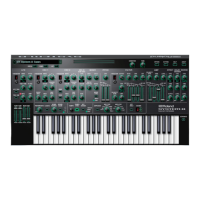Roland System-8 – historic turning point?
| 9
It’s not as easy as all that. And be assured, some of those sounds (we can only make comparisons on the basis of our
test candidate, the Jupiter-8 Plug-Out) were NEVER to be found on the original instrument. But then, that’s not the
point: to be fair, many of the System-8 sounds appear to be really useful. They inspire the player, in their own way, to
make music (creatively). Which is one very good argument in favor of a modern instrument.
Anyway, audio purists might discover some noise in the System-8 signal path, along with some (inexplicable) “ticks”
or drop-outs (listen to soundfile Electric Piano and you’ll know what we’re talkig about).
Special Assets and a couple of Question Marks
Now, stepping aside from all the sound details and conceptual extraordinaries, we reach the following fundamental
insight: the System-8 helps keep the good tradition of analog synthesis (here: virtual analog) alive.

